A Tour of the Leerburg Kennel Facility and Tips on Building Your Own Kennel
Note: Leerburg formerly bred working bloodline German Shepherds until deciding to shift its focus towards producing dog training videos and courses alongside providing quality dog training equipment. This article was written when our breeding program was still active. While Leerburg no longer breeds working GSDs, we believe this article may still provide valuable information for those interested in starting their own breeding program.
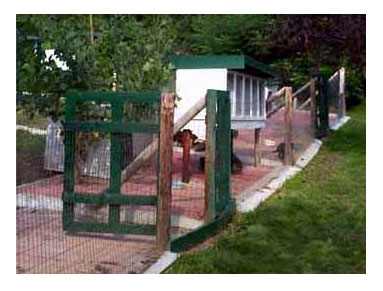
This page has two purposes. It will allow people to take a quick tour through my breeding facility. It is also intended to help new dog breeders learn from the mistakes I made in building this kennel. No one will ever build the perfect dog kennel, but maybe with a few ideas from this website, you can get some good ideas and learn from my mistakes.
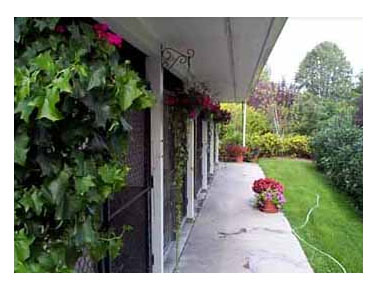
Aerial View of Our Kennels
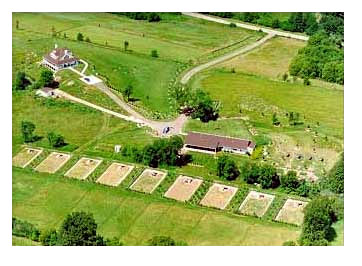
The kennel sits on 38 acres. The acreage is on a hill that is the third highest point in our county. This results in a constant breeze that reduces the number of bugs. The exercise yards are on the side of a hill which results in good drainage after rain and increases conditioning for the dog.
The 9 squares behind the kennel are 60' x 40' dog yards with a 20 ft. space in-between. The 20 ft. spacing is filled with pine trees so the dogs cannot see each other. All of the dog yards have shaded dog houses and since this photo was taken, there are shrubs and trees in each yard.
There are 8 puppy yards on the end of the kennel. Each kennel is 20' x 32.' The puppy area is surrounded by hedges to provide shade and privacy for the mothers and their litters.
The Back of Our Kennels
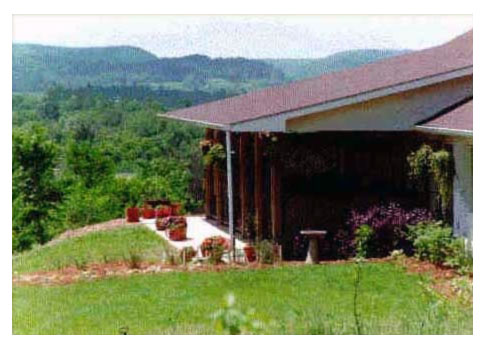
This is the view looking west (up the valley) from the back of the kennel. We have 13 indoor-outdoor runs with a roof over them to keep them dry. In the summer, we have a constant breeze. In the winter, we freeze our bottoms off. There are good and bad points with being up so high. When there is a quiet breeze in town, we have gale force winds on the hill. It can be a test of your will when it's 30 below zero and blowing 40 MPH in the winter.
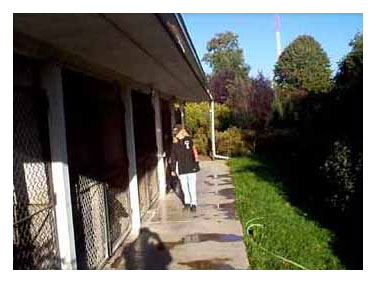
This photo shows some good and bad points of the facility. While I covered the dog runs, I did not cover the sidewalk in front of the runs. Had I to do it over, the roof would have extended over the whole sidewalk. I would have put concrete footings and a 2- or 3-foot block wall on the right side of the sidewalk. In the winter, I would have portable wall panels that would have sat on top of the wall so the entire run area could have been enclosed. The dog runs face south. I would have built double-panel glass windows into the removable panels so that solar energy could have been used to heat the runs on sunny days.
Notice the shade from the Lilac hedge on the right side. I have two different rows of lilac hedges (30 feet apart) between the kennel runs and the outside dog yards. This eliminates the dogs in the runs from seeing the dogs in the yards, which means less barking. I am a big believer in using landscaping to control barking. Hedges and trees go a long way toward cutting down on sound problems. They not only absorb sound but they act as walls. When the dogs can't see one another through trees and hedges, they bark a lot less and run the fence a lot less. I also believe the dogs themselves like it better. They certainly are calmer.
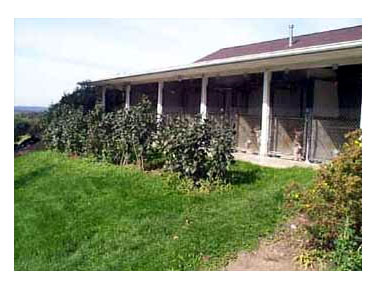
The photo shows the lilacs when they were just 2 years old. I buy them bare-rooted from the local nursery for about $6.00 per plant. That way, I know they will grow in our cold winter climate. The second row of lilacs is just to the right of this photo.
The Kennel Yards (40' x 60' Pens)
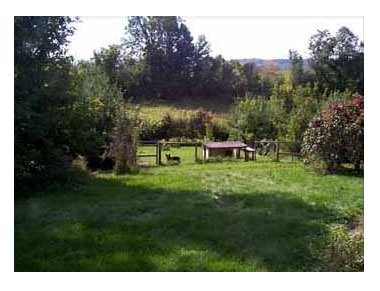
I prefer keeping the dogs in these 40X60 foot pens. I have 9 of them. The pens are built on a side hill with natural drainage to the back of the pen. You can see the dog standing in the yard and the doghouse and grooming table in each pen.
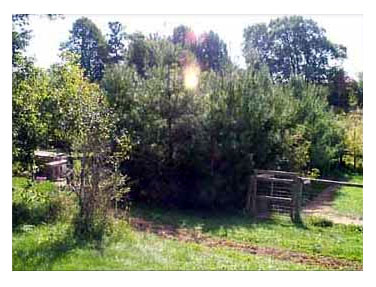
The dogs cannot see each other through these alleys. Every May and June, we fertilize each pine tree with the highest level of nitrogen fertilizer I can buy. This results in a 2-foot-per-year growth of the trees.
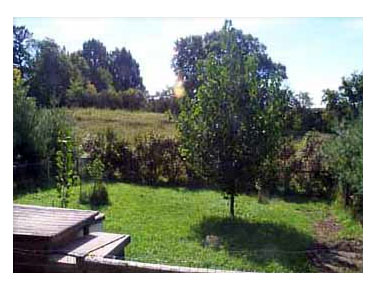
This photo demonstrates the shade trees in the yards. This is something I should have done the first day I built the dog yards. This tree is only 3 years old. I have planted fast-growing poplars in every yard. If I had it to do over, I would have 3 or 4 in each yard. The mid-summer sun is very hot. These trees are great for the dogs.
Initially, you will have to build wire enclosure around the trees to stop the dogs from digging them up and to stop the males from killing them by peeing on them. You can see one of the wire mesh cages around the small 3 ft. tree on the left. I found I had to use welded wire and not chicken wire. The dogs will go right through chicken wire. There are several first-year trees in this yard along with the 3-year-old tree.
The back of each yard has a hedge of "highbush cranberries". These are great for shade and the birds love the berries in the winter. My neighbor raises labs and horses. The hedge helps block the view and stop the barking (at least cut down on the barking) when he rides the horses or walks his dogs on the hillside next to my land.
Outside Kennel Runs: Good and Bad Points
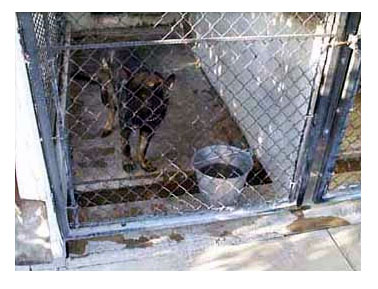
There are a number of problems with my dog runs. The runs are 6' x 12' with 4' high block walls in between each run. The runs have a 1" slope (this is not enough). I should have had the outside block walls be 6" tall (like the inside of the kennel). The slope of the runs should be 3" to 4" back to front in 10' length. The drain trough was supposed to be outside the dog run.
The first mistake I made was having a friend pour the concrete. DO NOT DO THIS! When mistakes are made by friends, you are more likely to accept the mistake. I should not have. If an outside contractor is used and he makes a mistake, you will be more likely to insist on him fixing the mistake. In this case, the concrete was poured when I was out of town. I had asked for a 4" slope and got 1" that does not drain properly. Contractors do not understand dog runs. We want the water to run off quickly. It makes cleaning easier and quicker. The more they run off, the quicker they dry. I had asked for the drain trough to be outside the pens but they are inside. Make your contractor sign and initial this part of your agreement. Do not leave it to a verbal agreement.
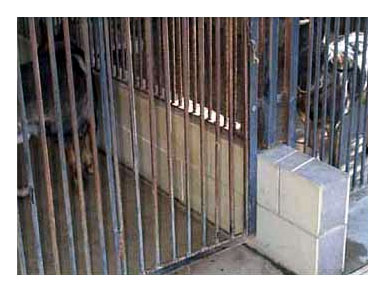
While the runs on the back of the building have 4' walls, the runs on the front have 2 block high walls. This limits the dogs that can be kept side by side (fence fighting is a pain). A 6' wall is the best. The roof does not sit on top of the walls so there is plenty of fresh air to circulate for ventilation.
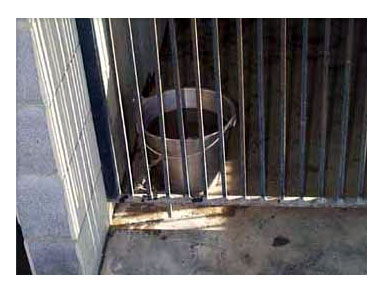
This photo shows the welded steel bar gates I have for some of the dog runs. I like these better than chain link gates. Some dogs that I get hate kennels. They will rip at chain link but leave these bars alone. These are expensive to make but last a long time and look nice when spray-painted back.
I also use these large stainless-steel buckets. They are fastened to the wall with clips. They are easy to disinfect and the dogs cannot chew them up. They last forever compared to rubber or galvanized buckets. They are not cheap.
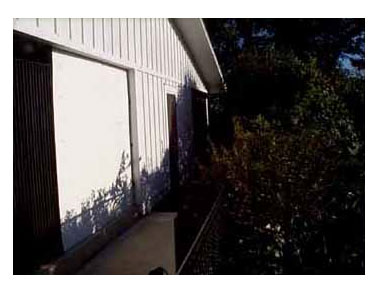
The kennel building faces north and south. The west end of the building has runs exposed to the west. In July and August, these runs will almost bake a dog in the late afternoon. I planted lilac bushes to offer late afternoon shade for these dog runs. I should have done this the first year I built the kennel. I did not. The taller ones at the rear are 4 or 5 years old and the younger bushes to the front are 3 years old. I have put up white plywood for shade until the smaller lilacs grow up.
Using shrubs to naturally cool and shade your facility is a long-term project but much better looking and in the long run, cheaper. The thing with this approach is that you need to get going and do it on day one, then fertilize with high nitrogen fertilizer in mid-May and mid-June.







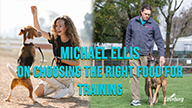
Ask Cindy.